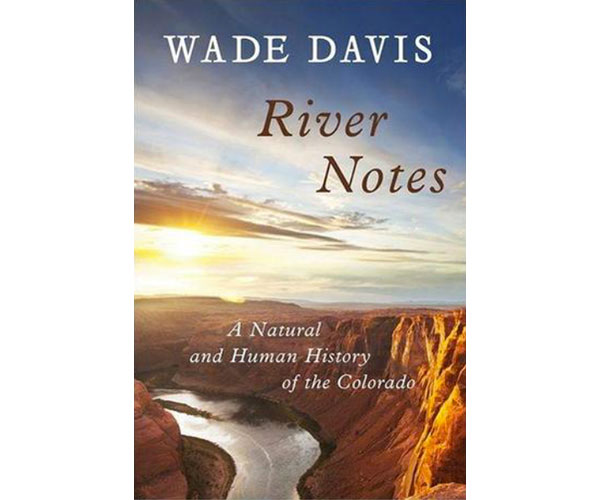
Author: Wade Davis (Island Press, 2012)
I was shocked that I had not heard of Wade Davis before reading this book. For a man who has seen and done so much in his time, I find him a quiet victor, and to take an appropriate quote from his most recent book River Notes: “Men parsimonious with language but active in deed inspire confidence.”
Like the fourteen books that came prior, Davis’ River Notes is chalk full of beautiful language, but it is the sheer act of writing this fantastic book that inspired me. Too often a poetic look at a subject is brushed off as art or a non-intellectual, but River Notes proves the opposite. Laced with just enough of the sharp edged facts to prove he knows what he is talking about (and dares you to challenge him), Davis is at once a historian, an ecologist, and (my favorite) a hearty traveler. His journey along the banks of the Colorado, through the Grand Canyon is as rich as his telling of the history of how all of this land came to be.
The book doesn’t have a typical order, which allows it to flow in an almost majestic manner throughout the different issues Davis wishes to address. He inserts bits of history when it is pertinent to the story, not only in the standard introduction to the book. This makes it possible to move seamlessly through different areas of study and focal points—from the aboriginal people who roamed the shores of the Colorado long before American Settlers, to the trials and interesting histories of Brigham Young and his Mormon quest toward Salt Lake City as well as some of the first adventures of explorers down the Colorado, through the Grand Canyon.
While he is discussing these topics, he is constantly bringing us back to the adventure he is on at the tome of his writing—travelling, himself, down the Colorado. Spliced in with all of his wonderful anecdotes are histories and scientific data pertaining to the damming of the river, the consequences of the many actions taken, and some outlook on its future, should things remain the same.
Just past the half-way point of the book, Davis takes readers aside to tell us about something he remembers from his past: a time when speaking to a former professor and friend (David Brower), who in 1971 was “already a legend in the environmental community.” The interesting part of this anecdotal tangent was not when Davis was told by Brower that he could change the world—that anyone is capable of changing the world for that matter—but what he said after:
Always remember, he cautioned, that no environmental victory is final. Nothing is ever fully protected. Every battle won only reveals new frontiers of conflict, because the forces of greed and self-interest, as he put it, always reemerge.
How fitting that this conversation took place in 1971 and that we are confronted with this truth today. One need not look far to draw parallels between the greed driven plight of the Colorado through Davis’ research—its dams, the creation of new, man-made lakes which do nothing but harm the ecosystem they say is being protected—and many of the environmental conflicts we see around us today. Many would put the British Columbia’s Enbridge Northern Gateway Pipeline in this category, for example.As Davis points out, however, it is not a herculean task to solve many of these problems through analysing and questioning them critically.
As one can see, through the beautifully written River Notes: A Natural and Human History of the Colorado, Wade Davis has provided another powerful book that provokes and challenges readers, at a number of levels. To read about the history of the Colorado—how the aboriginals were wiped out, the people driven from their lands, the almost complete standstill that the river has come to compared to its former glory, and how much worse things are becoming—should be a message to all that there are some aspects of life left best untouched and untamed.
***
For more information, visit the Island Press website or Wade Davis’ website.
**
Jeremy Senko is happily lost in the world of theoretical architecture and design. He is forever a student at heart, consistently reading, experiencing and learning about the world he inhabits. More specifically, he recently completed his Bachelor of Interior Design at Kwantlen Polytechnic University, where he pushed the limits (and the patience) of his professors.

